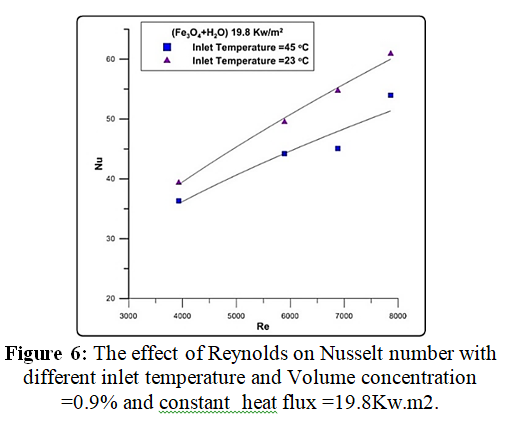The Effects of Magnetic Nanofluid Flow with Different Heat Flux and Magnetic Field on Heat Transfer Through Horizontal Pipe
DOI:
https://doi.org/10.71229/njemcs.v1i1.1Keywords:
Nanofluid , Heat transfer, Magnetic field , field Heat fluxAbstract
The influence of using nanoparticles with and without magnetic field on the characteristics of the flow and heat transfer rate is experimentally through a horizontal pipe. The base working fluid is distilled water, and the added nanoparticles are iron oxide (Fe3O4), with a volume fraction of (φ= 0.3, 0.6 and 0.9%). The intensity of the supplied magnetic field is (0.1 Tesla). The experiments are conducted at different heat fluxes (12.7, 15.9, 19.8 kW/m2), two different inlet temperatures (23, 45 oC), four different flow rates (2, 3, 3.5, 4, l/min) and range of Reynolds number (3930-7860). The results show that an increase in the concentration of nanofluids and heat flux give a boost in Nusselt number. Also, it is found that the use of a magnetic intensity enhances further heat transfer. The maximum enhancement in Nusselt number is about (18.3%) without using a magnetic field, and (20.1%) with the magnetic field, at a concentration of nanofluid of (φ = 0.9%) and lower heat flux.
References
[1] Razi, P., Akhavan-Behabadi, M.A. and Saeedinia, M., 2011. Pressure drop and thermal characteristics of CuO–base oil nanofluid laminar flow in flattened tubes under constant heat flux. International Communications in Heat and Mass Transfer, 38(7), pp.964-971.
[2] Al-Dulaimy, F.M.A., 2013. Heat Transfer Enhancement in MCHS using Al2O3/Water Nanofluid. Tikrit Journal of Engineering Sciences, 20(2), pp.1-12.
[3] Saeedinia, M., Akhavan-Behabadi, M.A. and Nasr, M., 2012. Experimental study on heat transfer and pressure drop of nanofluid flow in a horizontal coiled wire inserted tube under constant heat flux. Experimental Thermal and Fluid Science, 36, pp.158-168.
[4] Malvandi, A., Kaffash, M.H. and Ganji, D.D., 2015. Nanoparticles migration effects on magnetohydrodynamic (MHD) laminar mixed convection of alumina/water nanofluid inside microchannels. Journal of the Taiwan Institute of Chemical Engineers, 52, pp.40-56.
[5] Sheikholeslami, M., Rashidi, M.M. and Ganji, D.D., 2015. Effect of non-uniform magnetic field on forced convection heat transfer of Fe3O4–water nanofluid. Computer Methods in Applied Mechanics and Engineering, 294, pp.299-312.
[6] Hatami, N., Banari, A.K., Malekzadeh, A. and Pouranfard, A.R., 2017. The effect of magnetic field on nanofluids heat transfer through a uniformly heated horizontal tube. Physics Letters A, 381(5), pp.510-515.
[7] Karamallah, A.A., Habeeb, L.J. and Asker, A.H., 2016. The Effect of Magnetic Field with Nanofluid on Heat Transfer in a Horizontal Pipe. Al-Khwarizmi Engineering Journal, 12(3), pp.99-109.
[8] Goharkhah, M., Gharehkhani, S., Fallah, S. and Ashjaee, M., 2019. Dynamic measurement of ferrofluid thermal conductivity under an external magnetic field. Heat and Mass Transfer, 55(6), pp.1583-1592.
[9] Sundar, L.S., Naik, M.T., Sharma, K.V., Singh, M.K. and Reddy, T.C.S., 2012. Experimental investigation of forced convection heat transfer and friction factor in a tube with Fe3O4 magnetic nanofluid. Experimental Thermal and Fluid Science, 37, pp.65-71.
[10] Brinkman, H.C., 1952. The viscosity of concentrated suspensions and solutions. The Journal of Chemical Physics, 20(4), pp.571-581.
[11] Wasp F.J., Solid–Liquid Slurry Pipeline Transportation, Trans. Tech., 1977.
[12] Gnielinski, V., 1976. New equations for heat and mass transfer in turbulent pipe and channel flow. Int. Chem. Eng., 16(2), pp.359-368.
[13] Holman, J.P., Heat Transfer, 10th ed. Mc-GrawHill Higher education, USA, 2010.
[14] White, F. M., Fluid Mechanics, 4th ed., MacGraw-Hill books, USA, 2001.

Downloads
Published
Issue
Section
License
Copyright (c) 2024 Laith Jaafer Habeeb, Abdulhassan A. Karamallah, Ali Habeeb Askar

This work is licensed under a Creative Commons Attribution 4.0 International License.









